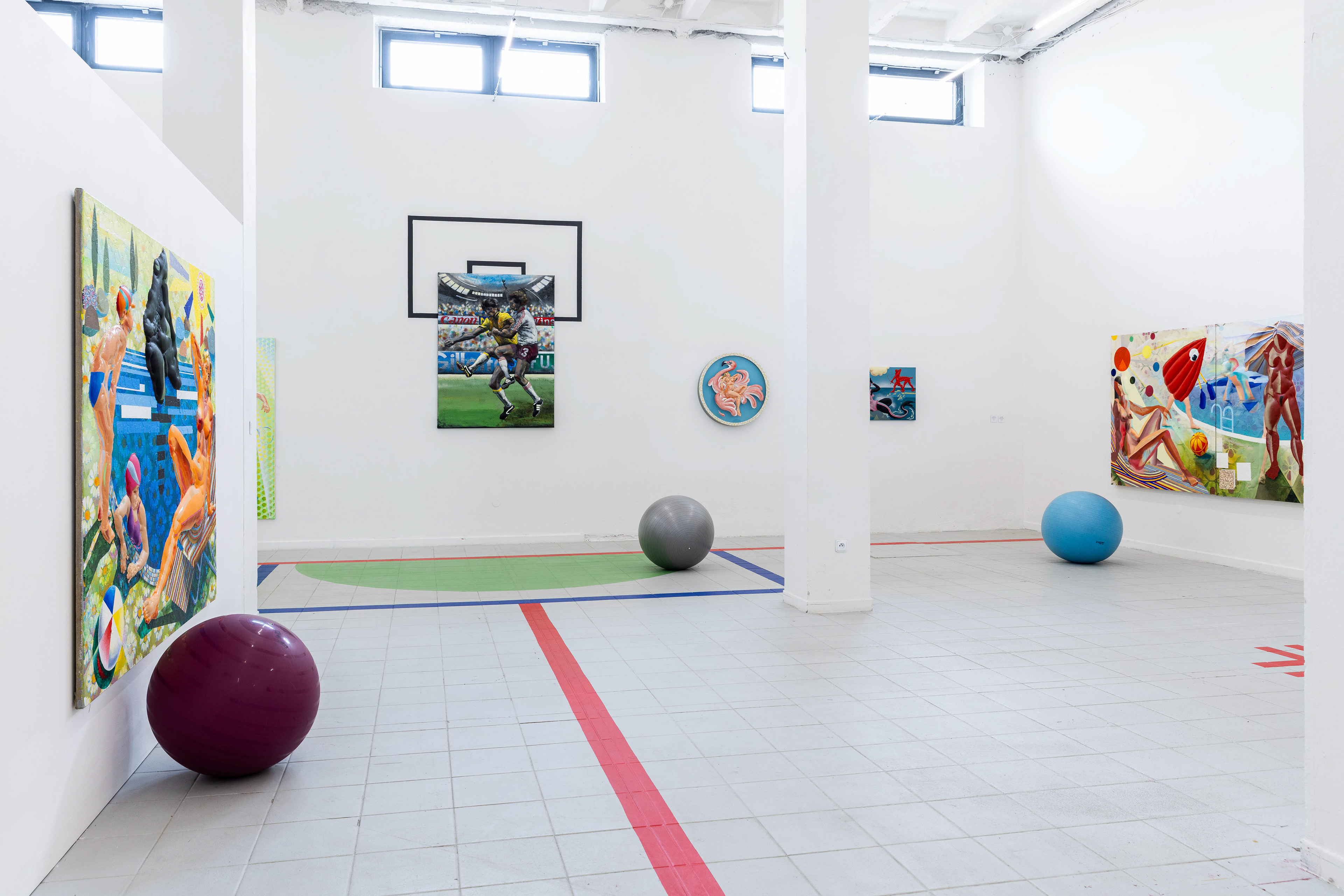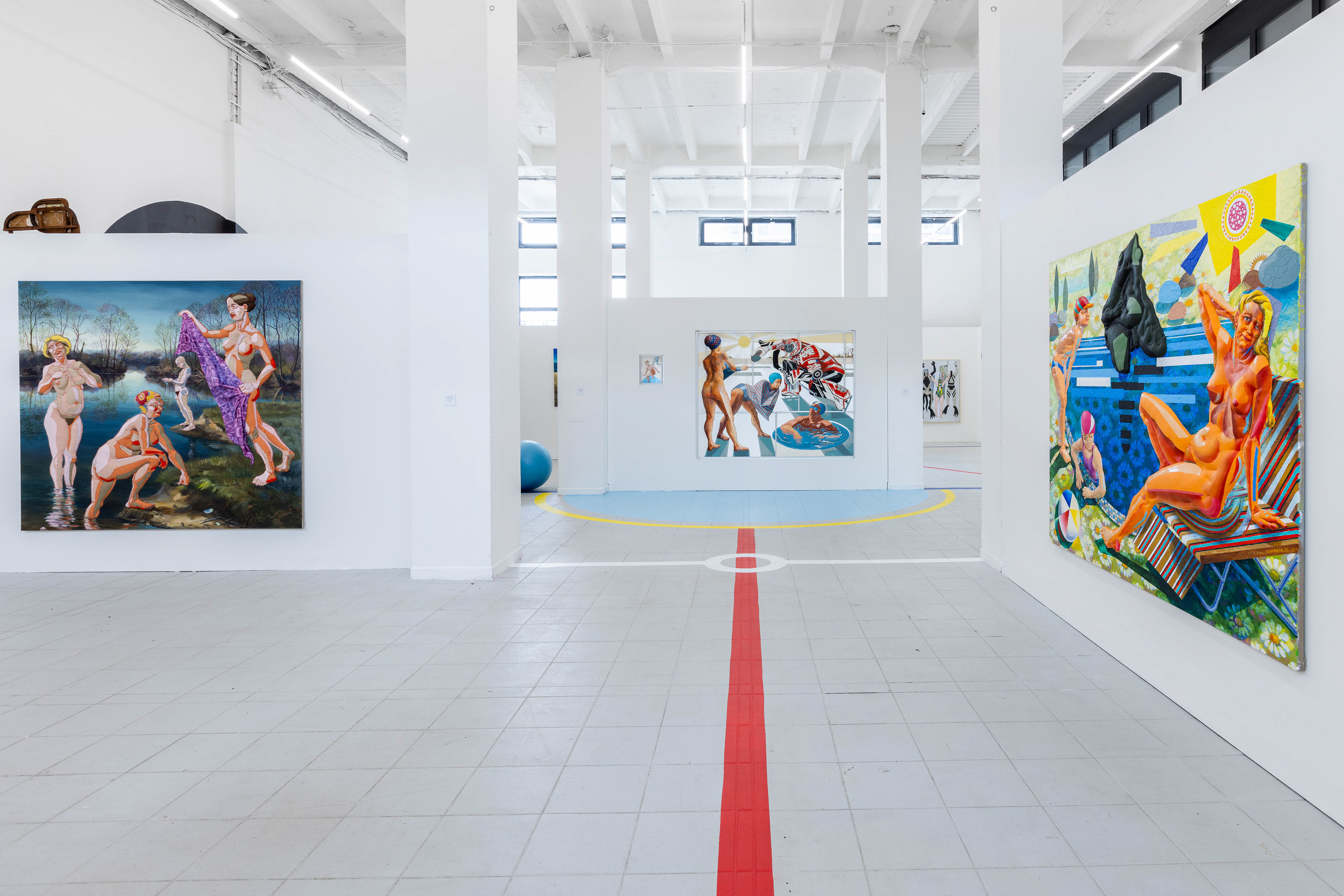Vojtěch Horálek / Venuše a znakoplavci
The Chemistry Gallery
13. 6. – 12. 7. 2025
Curated by Martina Mrázová
Photo: Markéta Ambrožová








Každodenní přetechnizovaný svět, přehlcený informacemi a vizuálním balastem, se i pro člověka samotného stal nesnesitelným a dlouhodobě neudržitelným. Jako již mnohokrát v minulosti opět hledáme naději v návratu k přírodě, v představě napojení na cosi původního, čistého a autentického. Ve snaze o obnovení tělesných i duchovních sil se pravidelně noříme do chladivých vod rybníků, moří, nebo alespoň bazénů a vystavujeme svá těla účinkům slunečního záření. Hojivý a terapeutický potenciál slunečních paprsků však lidstvo svou vlastní činností dávno narušilo a bez patřičných ochranných prostředků pro nás může být prostý pobyt v přírodě mnohdy paradoxně i život ohrožující.
Motiv trávení volného času u vody se malíři Vojtěchu Horálkovi stává platformou pro úvahy nad ambivalentním vztahem přírody a lidské společnosti s její povrchností, marnivostí, pokrytectvím a bezohlednou honbou za individualistickým úspěchem. V názvu výstavy Venuše a znakoplavci se setkává několik aspektů, které jsou pro autorovu tvorbu typické – osobitá poetika plná hravosti a jemného humoru spolu s odkazy k historii lidstva, antické mytologii, dějinám umění, kosmologii a nově také k biologii. Rod mytických Venuší a nepřemožitelných héroů s vyrýsovanou muskulaturou a minimem tělesného tuku zprostředkovává v Horálkových dílech prolínání světů různých řádů a hierarchií, jak napovídá i narážka na dravý druh vodního hmyzu v názvu výstavy.
Z obrazů a objektů Vojtěcha Horálka se doslova vynořují těla koupajících se krasavic a sportovců, jako by byla vytlačována z vodní hladiny, která je vytrvale odmítá přijmout za své. Navzdory poklidné atmosféře maleb, jejichž podkladem často není plátno, ale plexisklo, dřevo či jiné nezvyklé materiály, zde lidské postavy působí jako elementy z jiného světa, které do idylických výjevů tak úplně nezapadají. Šité polstrované figury plasticky vystupují z obrazové plochy a svým zhmotňováním narušují pocit bezstarostnosti a pohody, která se line harmonickou iluzivní malbou. Krajiny jsou navíc mnohdy namalovány na zadní stranu obrazu a divákovi se ukazují skrz polopropustné plexisklo, jako bychom nahlíželi do nějakého vzdáleného, pohádkově idylického světa. Postavy, mnohdy nahé nebo spoře oděné do plavek, nepůsobí krásně ani smyslně, ale spíše groteskně, bizarně, či dokonce děsivě. Jsou vměstnány do stísněných vířivek nebo zaujímají efektní pózy, jako by se ocitly na podivném jevišti, vyzbrojeny slunečními brýlemi, ručníky a lehátky s pestrým dekorem, který často prorůstá i spodními vrstvami obrazu a připomíná pestrobarevné vzory, jež kdysi lemovaly normalizační iluze o budoucím pokroku lidstva. Proporce figur jsou někdy deformovány částečným vnořením do vody, ale také zdvojováním a vrstvením malířsky iluzivní a reliéfní plasticity. Kvůli vynořování z obrazové plochy se zároveň stávají křehkými a zranitelnými, a tak je malíř vybavuje čepicemi či masivní hokejovou výstrojí, aby lépe odolávaly nebezpečí vnějšího světa.
Neustálá snaha člověka po splynutí s přírodou se zde ukazuje jako pouhá romantická iluze, časově limitovaný sen o symbióze. Nakonec ale dovolená vždycky skončí a my se opět musíme vrátit do civilizace, do bezpečí a tepla našich domovů, odkud můžeme promýšlet nové způsoby soužití s přírodou i s jinými bytostmi. Dokud ještě nějaká voda v našich maloměstských bazéncích a rybnících vůbec zbývá.
Vojtěch Horálek (* 1983, Praha) je malíř a grafik. Vystudoval v ateliéru malby Michaela Rittsteina na Akademii výtvarného umění v Praze (2004–2010) a během studií absolvoval studijní stáž na École supérieure d’art d’Aix en Provence. Jeho osobitý styl spoluutvářelo i předchozí studium oboru řezby, tvarování a restaurování dřeva na Střední a Vyšší odborné uměleckoprůmyslové škole v Praze (1998–2004). Má za sebou také zkušenost s produkcí videí, krátkých filmů a loutkového představení a pravidelně pořádá happening Staroboleslavská pouť. Vůči tlaku technologií se vymezuje mimo jiné bojkotem sociálních síti i svými „dřevěnými webovými stránkami“.
Patřil mezi finalisty prestižní ceny 333, pořádané NG v Praze (2012) a soutěže Jungart (2009). Za výtvarné zpracování hry Lakomá Barka získal ocenění Loutkářská Chrudim (2008).
Pravidelně vystavuje v Česku i v zahraničí, například v NG v Praze, v Českém centru v Berlíně, v GASK v Kutné Hoře, v Rabasově galerii v Rakovníku. Jeho tvorba je zastoupena v Severočeské galerii výtvarného umění v Litoměřicích, ve sbírce COLLET Prague | Munich av řadě dalších sbírek.
Od roku 2011 působí jako odborný asistent na Katedře alternativního a loutkového divadla DAMU.
Martina Mrázová
The contemporary world controlled by technologies and overloaded with information and visual smog has become unbearable and unsustainable even for humans themselves. Once again – like many times in the past – we are thus searching for hope in the embrace of nature, wishing to connect with something genuine, pure, and authentic. We dive into the cool waters of ponds, seas, or at least swimming pools and expose our bodies to the sun, hoping to restore our physical and psychological strength. Yet humans have long ago spoilt the healing and therapeutic effects of sunrays by their own activities, so paradoxically, just being in nature without sunscreen is potentially life-threatening.
Painter Vojtěch Horálek uses the motif of spending leisure time by the water as a platform for contemplating the ambivalent relationship between nature and human society, vitiated with superficiality, vanity, hypocrisy, and ruthless pursuit of individual success. The title of the exhibition Venuses and Backswimmers captures several characteristic aspects joined in the artist’s work: his peculiar poetics, playful and delicately humorous, interspersed with references to the history of humankind, ancient Greek mythology, history of art, cosmology, and (more recently) biology. In Horálek’s paintings, the genus of mythical Venuses and invincible heroes with chiseled figures and virtually no body fat reflect the intermingled worlds of different orders and hierarchies, as implied by the allusion to the predatory aquatic insect species in the exhibition title.
Bathing beauties and athletes literally emerge from his paintings and objects, as if pushed out by the water surface that stubbornly refuses to accept them as part of the water body. Despite the calm atmosphere of the pictures – often painted on plexiglass, wood, or other uncommon materials, rather than canvas – the human figures seem alien and not quite fitting into the idyllic scenes. Sewn and padded figures plastically protrude from the picture surface, their materialization disturbing the sense of lightheartedness and serenity that emanates from the harmonious illusory paintings. Moreover, the landscapes are often painted on the reverse side of the picture and are revealed to the viewer through a semi-transparent plexiglass, as if we were peeking into a distant, magical idyllic world. The figures, often naked or dressed in miniature swimwear, are neither beautiful nor attractive, but rather grotesque, bizarre, or even frightening. They are squeezed into cramped whirlpools or strike showy poses, as if standing on an odd stage, armed with sunglasses, towels, and lounge chairs adorned with colourful patterns that often protrude to the lower layers of the paintings, reminding of the bright-colour patterns that once illustrated the communist delusions of humankind’s eternal progress. The figures’ proportions are sometimes distorted by partial immersion in water or by doubling and layering of the painterly illusive and embossed plasticity. Having emerged from the picture surface, the figures become fragile and vulnerable, wherefore the painter equips them with hats or massive hockey gear to resist the dangers of the outside world.
The incessant human quest for merging with nature is exposed here as a mere romantic illusion, a temporary dream of symbiosis. Eventually, every holiday must come to an end, and we are forced to return to civilization, to the safety and warmth of our homes, where we can contemplate new means of coexisting with nature and other beings. As long as there is at least some water left in our bourgeois pools and ponds.
Vojtěch Horálek (born 1983, Prague) is a painter and graphic designer. He studied at the painting studio under Michael Rittstein at the Academy of Fine Arts in Prague (2004–2010). During his studies, he completed a study internship at the École supérieure d'art d'Aix-en-Provence. His previous studies of wood carving, shaping and restoration at the Secondary and Higher Professional School of Applied Art in Prague (1998–2004) informed his distinctive style. Horálek has also produced videos, short films and puppet shows and regularly organizes a happening called Staroboleslavská pouť (a pilgrimage to the town of Stará Boleslav). He asserts resistance to the pressure of technologies by boycotting social media and creating his “wooden website”, among other things.
He ranked among the finalists of the prestigious 333 Award, organized by the National Gallery in Prague (2012), and the Jungart competition (2009). He won the 2008 Puppeteers’ Chrudim Award for his set design for the production of the fairy tale Lakomá Barka (Mean Barka).
Horálek’s works have been shown at exhibitions at home and abroad, for example at the National Gallery in Prague, the Czech Centre in Berlin, the GASK gallery in Kutná Hora, and the Rabas Gallery in Rakovník. His works are further presented at the North Bohemian Gallery of Fine Arts in Litoměřice and included in numerous collections, such as COLLET Prague | Munich.
Since 2011, Horálek has worked as an assistant professor in the DAMU Department of Alternative and Puppet Theatre.
Martina Mrázová